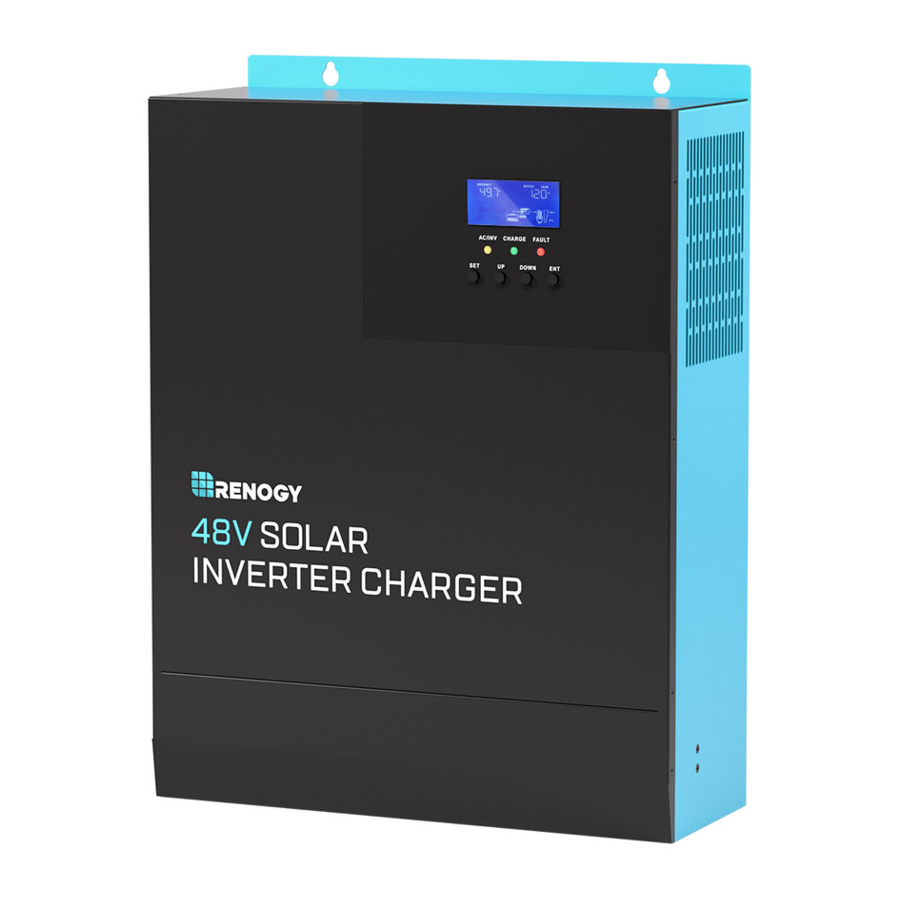
Advertisement
- 1 General Information
- 2 Product Overview
- 3 Dimensions
- 4 Installation
- 5 Communication Ports
- 6 Operation
- 7 LCD Programmable Features
- 8 Electronic Protections
- 9 Fault Codes
- 10 Maintenance
- 11 Technical Specifications
- 12 Charging Parameters Glossary
- 13 CONTACT INFORMATION
- 14 Important Safety Instructions
- 15 Documents / Resources

General Information
The new all-in-one Renogy Solar Inverter Charger is an advanced hybrid system combining the advanced charging algorithm of solar and industrial reliability and electrical energy of pure sine wave inverters to give you a complete power system. The unit features 4 charging modes and 3 output modes to meet an array of application needs. Utilizing the latest MPPT tracking technology, the solar charging module can quickly track the maximum power point of the photovoltaic array in any environment, capturing the maximum energy of solar panels in real time. The AC-DC charging module adopts an advanced control algorithm resulting in a powerful battery charger. The DC-AC inverter module is based on an all-digital intelligent design, using advanced SPWM technology to output pure sine wave converting direct current into alternating current, suitable for ac loads such as household appliances, power tools, and industrial equipment. The product adopts a segment LCD display design, which displays the operating data and operating status of the system. Lastly, the solar inverter charger has comprehensive electronic protections to ensure that the entire system is more secure and stable.
Key Features
- Powerful bypass function with uninterrupted power supply function.
- 4 charging modes: PV Priority, Utility Priority, Hybrid Charging, Only Solar.
- State-of-the-art MPPT technology with efficiency of up to 99.9%.
- Dynamic LCD display and intelligent LEDs providing important system information.
- Manual ON/OFF switch controlling AC output.
- Power saving mode function, reduce empty load loss.
- Adjustable fan, efficient heat dissipation, extending the life of the system.
- Supports lead-acid battery and lithium battery types.
- Complete electronic protection including: short-circuit protection, over-voltage protection, overload protection and more!
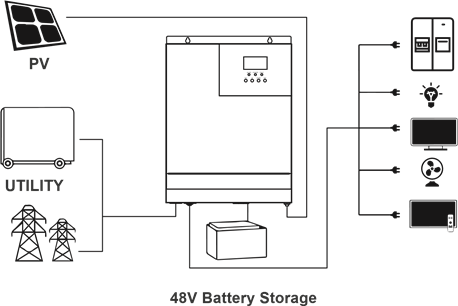
Photovoltaic Modules (PV): convert light energy into DC power, charge the battery through the solar inverter charger, or directly reverse into alternating current to power the load.
Power or generator (Utility): Access at the AC input can power the load and charge the battery. If you do not have a power supply or generator, the system can also operate normally, where the load is supplied by batteries and photovoltaic modules.
Battery: The role of the battery is to ensure the normal use of electricity for the system load when the solar energy is insufficient and there is no electricity.
Household load: Can be accessed to a variety of household and office loads, including refrigerators, lamps, televisions, fans, air conditioning and other AC loads.
Battery Charging Modes
The solar inverter will have 4 operational charging modes which changes the logic as how and when to charge the battery banks. The solar inverter has four working modes: PV priority, Utility Priority, Hybrid Charging, and Only Solar Charging.
PV Priority
In PV Priority mode it will make full use of the solar input during the day in order to charge the battery bank. This effectively allows using the unit off-grid during peak utility times in order to cut costs on utility charging. Only when solar fails to start or is interrupted will the unit automatically switch to utility mode for backup.

Utility Priority
In Utility Priority mode, the detected AC input will be priority for battery charging. If the power becomes unstable or unusable, then it will switch to PV charging.

Hybrid Charging
In Hybrid Charging, PV and Utility will work together to charge the battery bank at the same time. Priority will be given to PV and utilize MPPT charging. Upon PV charging being insufficient, the power supply replenishes with Utility power. This method is the fastest to charge and suitable for unstable areas of the grid, ready to provide adequate backup power supply.

Only Solar Charging
Only solar charging is the most energy-efficient way to charge your battery bank and does not make use of AC input. Utility will not charge the battery, even if it is available.
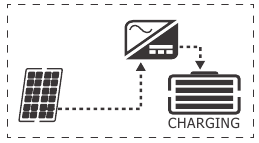
Load Output Working Modes
The solar inverter has 3 working modes that dictate how the incoming power is used to power the loads. Users may configure the output source priority to configure load power.
PV Priority
In this mode only the incoming solar energy and battery power are used to power the loads. This can maximize the use of green energy when selecting PV priority in Battery Charging Mode to achieve overall energy conservation and emission reduction. Upon there being no more usable solar energy or the battery voltage drops to a low voltage setpoint, then the unit will switch to utility power to continue to power up the loads. It is recommended to be in this mode for relatively stable areas.

Utility Priority
Equivalent to a backup UPS for use in unstable areas of the grid, Utility will provide power to the loads as priority. Solar and battery energy will provide power to the loads only when utility power is not available.

Inverter Mode
The Battery energy will supply power to the loads. Utility provides power to the loads only when battery voltage drops to low voltage which maximizes the use of DC power.

Product Overview
Identification of Parts
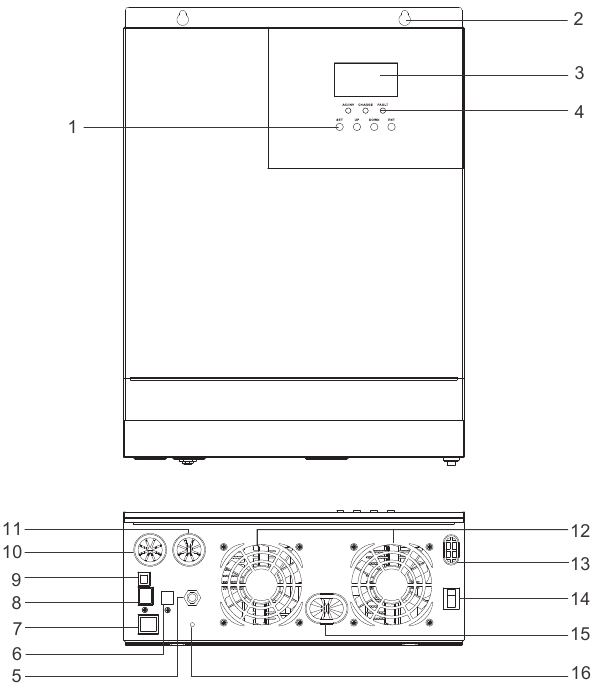
Key Parts
- LCD Buttons
- Mounting Holes
- LCD Screen
- LED Indicators
- AC Input Breaker
- Wired Remote Port
- Dry Contact Port
- RS485/CAN Communication Port
- USB Debugging Port (Internal Use)
- AC Input Terminal
- AC Output Terminal
- Cooling Fans
- PV Input Terminal
- Main On/Off/Remote Power Switch
- Battery Input Terminal
- Grounding Lug
Dimensions
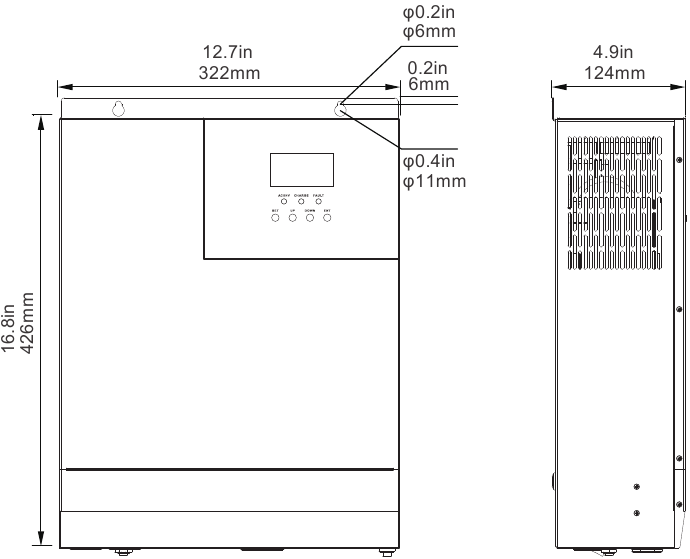
Optional Components
Renogy BT-2 Bluetooth Module:
The BT-2 Bluetooth module is a great addition to any Renogy charge controllers with a RS485 port and is used to pair charge controllers with the Renogy BT App. After pairing is done you can monitor your system. No more wondering how your system is performing, now you can see performance in real time without the need of checking on the controller's LCD.
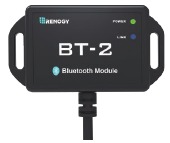
Wired Remote Control:
The remote for the solar inverter gives users the opportunity to power on/off from a distance. Giving you approximately 16.4ft of distance, simply connect the cable to the remote port on the unit. Make sure the solar inverter main power switch is set to REM.
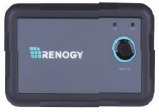

Installation
Please read this manual carefully and familiarize yourself with the installation procedures before installation.
 | Indicates a potentially dangerous condition. Use extreme caution when performing this task. |
 | Indicates a critical procedure for safe and proper operation of the inverter. |
 NOTE NOTE | Indicates a procedure or function that is important to the safe and proper operation of the inverter. |
Location Recommendations
Never install the inverter in a sealed enclosure with flooded batteries. Gas can accumulate and there is a risk of explosion.
Ensure installation follows the following guidelines:
- Cool, dry, well-ventilated area — Heat is the worst enemy for electronic equipment. Inverters must be in an area where the fans are not blocked or where they are not exposed directly to the sun. They should be in an area free of any kind of moisture and allow for clearance of at least 8" around the unit to provide adequate ventilation.
- Protection against fire hazard — the unit should be away from any flammable material, liquids, or any other combustible material. The unit can spark and the consequences could be severe.
- Close proximity to battery bank—prevent excessive voltage drop by keeping the unit close to the battery bank and having a properly sized wire going from the battery bank to the inverter.
Do not install the inverter in the same compartment as the battery bank because it could serve as a potential fire hazard.- Limiting electromagnetic interference (EMI) — ensure the inverter is firmly grounded to a building, vehicle, or earth grounded. Keep the inverter away from EMI receptors such as TVs, radios, and other audio/visual electronics to prevent damage/interference to the equipment.
Other Precautions:
- When installing the battery, be very careful, when installing lead-acid liquid batteries, you should wear protective glasses, once in contact with battery acid, please wash with water in time.
- Avoid placing metal objects near the battery to prevent short circuits in the battery.
- Acid gas may be generated when the battery is charged so ensure good ventilation around the environment.
- Incorrect or improper connection points and corroded wires can cause great heat to melt the wire insulation, burning surrounding materials, and even cause fire, so ensure that the connection is tightened
- It is best to avoid mobile applications when the wire shakes and cause the connection head loose.
- Outdoor installation should avoid direct sunlight and rain, snow.
- Do not install the solar inverter in harsh environments such as damp, greasy, flammable and explosive areas or where dust accumulation is high.
- The municipal electrical input and AC output are high voltage, do not touch the wiring.
- Do not touch the unit when the fan is working.
- To avoid damage, do not use more than one (in parallel) input AC power supply.
![Renogy - 48V - Installation - Location Recommendations Installation - Location Recommendations]()

Wiring
The Renogy Solar Inverter is suitable for 48V battery banks systems ONLY. Not following the minimum DC requirement may cause irreversible damage to the unit.
The solar inverter components at the AC input/output, battery components, and PV components will produce high energy output. Make sure to connect the appropriate component to the appropriate labeled terminals.
Be careful of the positive and negative poles. Reversing the poles may cause permanent damage to the inverter.

The input terminals of the inverters have large capacitors connected to them. Once a positive and negative wire are connected to the terminals, it will complete the circuit, and commence drawing a heavy current momentarily. As a result, there may be a sparking occurring even if the inverter is in the off position. To minimize sparking, it is recommended that the user have the appropriate size wire feeding into the solar inverters and/or install an external fuse leading into the inverter.
After the power switch is switched off, there is still high energy inside the solar inverter, do not open or touch the internal device, wait for the capacitance to be put off after the relevant operation.
Locate the power button on the solar inverter and make sure the solar inverter main power is turned off
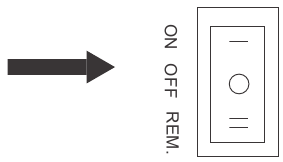

If using the wired remote, the switch should be set to REM.
Remove the terminal cover by unscrewing the appropriate terminals located on the face of the solar inverter
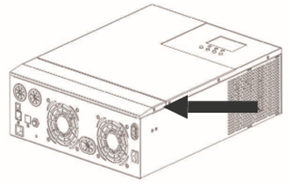
Wiring and installation methods must comply with national and local electrical specifications. The following chart is reference only. Longer wire runs between solar panels and the solar inverter as well as longer runs between the solar inverter and battery bank will require thicker wiring size to minimize loss and improve system performance.
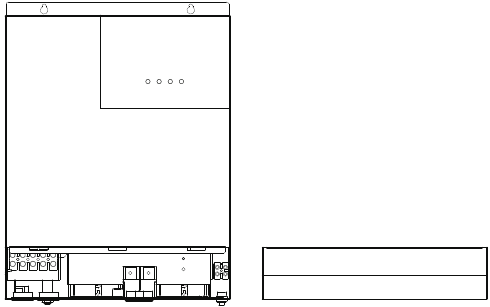
| Specification | Minimum Recommended Wiring AWG | Max Amps |
| Battery Wiring | 2AWG | 120A |
| PV Wiring* | 8AWG | 50A |
| AC Input Wiring | 8AWG | 40A Max Bypass |
| AC Output Wiring | 8AWG | 30A Continuous 40A Max Bypass |
Battery Wiring
Be careful of the positive and negative poles. Reversing the poles may cause permanent damage to the inverter.

The input terminals of the inverters have large capacitors connected to them. Once a positive and negative wire are connected to the terminals, it will complete the circuit, and commence drawing a heavy current momentarily. As a result, there may be a sparking occurring even if the inverter is in the off position. To minimize sparking, it is recommended that the user have the appropriate size wire feeding into the solar inverters and/or install an external fuse leading into the inverter.
| Rated Battery Discharge Current | Maximum Battery Charging Current | Recommended Wiring | Recommended Circuit Breaker | Recommended Ring Terminal |
| 85A | 120A | 2AWG | 2 pole, 140-160A | 5/16" |

Make sure any circuit breakers are disconnected and ensure the unit is in the off position.
The solar inverter takes a 48V battery input to operate. This will require combining 12V or 6V batteries in series to achieve the minimum voltage DC requirement. It is recommended to use battery cables with ring terminals. The ring terminals must be firmly tightened and secured on the respective battery terminals to prevent any excessive heating or resistance. Connect the positive and negative battery ring terminals to the respective positive and negative battery terminals on the solar inverter.
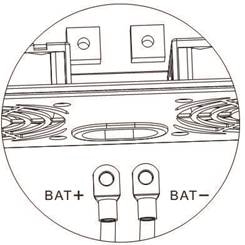
PV Wiring
| Maximum PV Input Current | Recommended Wiring | Recommended Circuit Breaker | Recommended Wiring |
| 50A | 8AWG | 2 pole, 100A |  Bare Wire Bare Wire |

For PV to charge 48V battery banks, you will need a minimum PV Voc voltage of 60VDC.
When combining panels in parallel it is recommended to use a combiner box for safety and organizational precautions. The solar inverter accepts a maximum of 150VDC input and requires a 48V battery input to operate. This will require combining solar panels in series or series parallel to achieve the minimum voltage DC requirement. Due to many factors affecting PV performance, it is recommended to utilize the open circuit voltage (Voc) when connecting panels in series to make sure you stay under the 150VDC input. For parallel connections, it is recommended to use the short circuit current (Isc) to make sure you are well under the 50A limit.
The bare wire terminal blocks must be firmly tightened and secured to prevent any excessive heating or resistance. Connect the positive and negative PV wire to the respective positive and negative PV terminal block on the solar inverter.
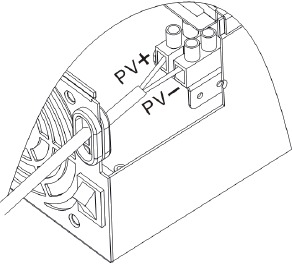
AC Output Wiring

Only the Live and Neutral wires will be connected to the Output Terminal Block, the Ground will be connected to the screw terminal.

Make sure any circuit breakers are disconnected and ensure the unit is in the off position.
AC Output should NEVER be connected to public power/utility or a generator.
There are two terminal blocks with "IN" and "OUT" markings. Please do NOT misconnect input and output connectors.
| Maximum Inverter Bypass Current | Recommended Wiring | Recommended Circuit Breaker |
| 40A | 8AWG |  2 pole, 40A 2 pole, 40A |
Carefully place the correct AC wire into the respective AC Output terminal block. The ground output cable will need to be connected to the ground screw terminal located separately from the output terminal block. It is recommended to keep ground as close as possible to the solar inverter charger, the shorter the ground wire, the better.
The order should be as follows:
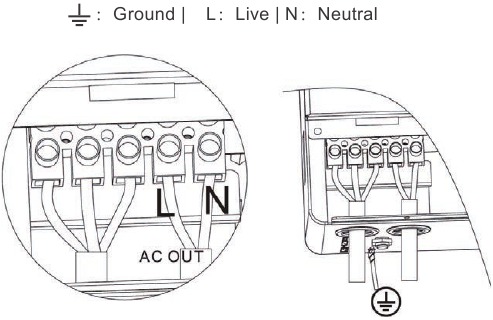
AC Input Wiring
The AC input must never be connected to the AC output as irreversible overload or damage may result

The AC Input Terminal Block is connected to circuit breakers for added protection. Do not modify or alter them as it may cause irreversible damage to the solar inverter.
There are two terminal blocks with "IN" and "OUT" markings. Please do NOT misconnect input and output connectors.
Run the AC input line through the AC input cable entry slot. Make sure to use appropriate cable sizing when working with AC. Carefully place the correct AC wire into the respective AC Input terminal block. The order should be as follows:
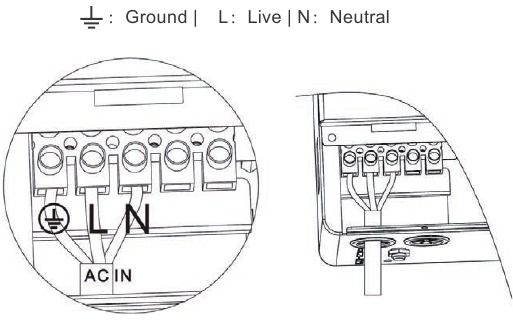
Communication Ports
Dry Contacts

To use this to function, an auto start controller must be installed on the generator. there are three contacts; up to down: NO, N, NC
Do not store units with auto gen start feature enabled. Generators exhaust dangerous fumes when running.
This contact automatically starts the generator and charges the battery bank. Under normal conditions, this terminal is NC-N point closed, NO-N point open. When the battery voltage reaches the low voltage point, the relay coil is energized, and NO-N point now is closed and NC-N point now is open.
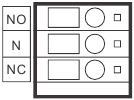


While the generator is connected, the unit now operates in "Charging Mode" with the AC power from the Generator charging the batteries as well as providing power to the AC loads.
RS485/CAN
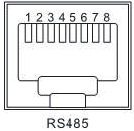
This port will be used for connecting to the BT-2 Accessory for remote monitoring and control.
| Pin No. | Parameter |
| 1 | 5V |
| 2 | RS485-A |
| 3 | RS485-B |
| 4 | GND |
| 5 | NC |
| 6 | CAN_H |
| 7 | NC |
| 8 | CAN_L |
USB
The USB port is for internal purposes only. It will not be supported as it requires proprietary information.
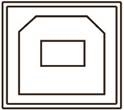

When using both USB and RS485, you can only use one of two alternatives, not use both simultaneously.
Operation
Assuming all connections are correct and tightly secured, Locate the power button on the solar inverter and turn the main power switch to the ON position.

The following describes the basic operation of the solar inverter charger

If using the Wired Remote and the main power switch set to REM, simply press to push button to turn on.
Wired Remote
The wired remote control is an alternative way to power on or off your solar inverter from a distance.
To operate:
- Make sure the push button on the wired remote is not pressed
- Flip the solar inverter switch to REM mode
- Connect the remote wire to the REMOTE port on the solar inverter model
- To confirm success, press the power button to power on the inverter via remote
![Renogy - 48V - Operation - Wired Remote Operation - Wired Remote]()
Wired Remote LED

| LED | Color | Behavior | Meaning |
| ON | Green | Solid | Behavior Powered On |
| Flash | Not connected |
LCD Operation
The solar inverter is equipped with 3 LCD indicators and 4 working buttons
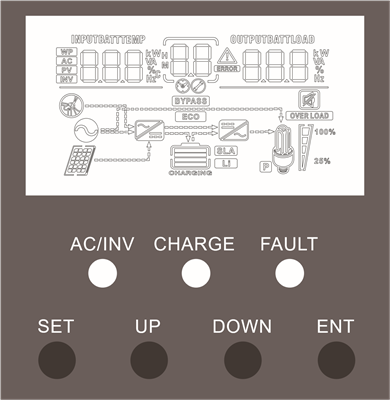
Tab.1
| LED | Color | Behavior | Parameter | |
| AC/INV | Yellow | Solid | The output will be powered by the AC Line | |
| Flash | The output is powered by battery or PV in battery mode | |||
| CHARGE | Green | Flash | Battery is charging | |
| FAULT | Red | Solid / Flash | System fault | |
Tab.2
| Key | Parameter | |||
| SET |  Go to / Exit Settings menu Go to / Exit Settings menu | |||
| UP | Previous selection | |||
| DOWN | Next choice | |||
| ENT | Under the Settings menu, determine/enter options | |||
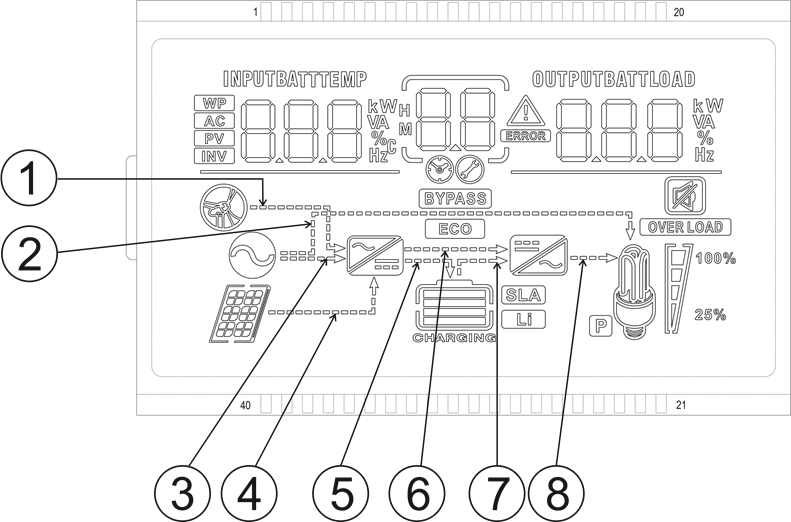
| 1 | The arrow only displays during startup and not part of the solar inverter functionality | 5 | Indicates that the charging circuit is charging the battery |
| 2 | Indicates that the utility/grid is powering the load | 6 | The arrow only displays during startup and not part of the solar inverter functionality |
| 3 | Indicates that the power utility/grid is powering the battery charging circuit (AC-DC) | 7 | Indicates that the battery is powering the inverter circuit (DC-AC) |
| 4 | Indicates solar (PV) power to the battery charging circuit (DC-DC) | 8 | Indicates that the inverter circuit is powering the load |
Icon & Function
![]()
![]()
LCD Menu Screens
On the LCD home screen, press the "UP"and"DOWN" buttons to turn the page to view the solar inverter's real-time data.
| 1 | Battery Input Voltage | Load Output Voltage | |
| 2 | PV Temperature | Fault code | PV Output Kilowatts |
| 3 | PV Input Voltage | PV Output Current | |
| 4 | Battery Input Current | Battery Output Current | |
| 5 | Battery Input Kilowatts | Battery Output Kilowatts | |
| 6 | AC Input Frequency | AC Output Load Frequency | |
| 7 | AC Input Voltage | AC Output Load Current | |
| 8 | Internal Parameters | Load Output KVA | |
| 9 | Inverter Temperature | Inverter Output Load Kilowatts | |
| 10 | APP Software Version | Bootloader Software Version | |
| 11 | Model PV Voltage Rating | Model Output Current Rating | |
| 12 | Model Battery Voltage Rating | Model PV Power Rating |
LCD Programmable Features
Press the "SET" key to enter parameter setting mode. After entering the settings menu, the parameter number 00 flashes and you can press the "UP" and "DOWN" keys to select the parameter code that you want to set. To access the parameter program press "ENT" key to enter the parameter editing state, at which point the value of the parameter flashes. Adjusts the value of the parameter through the "UP" and "DOWN" buttons, and finally press "ENT" to press the key, complete the edit of the parameter, and return to the parameter selection state.
| Parameters Number | Parameter Name | Set options | Description |
| 00 | Exit | [00] ESC | Exit the settings menu |
| 01 | Load Working Mode | [01] SOL |
Utility provides power to the loads only when any one condition happens:
|
| [01] UtI(Default) | Utility will provide power to the loads as priority. Solar and battery energy will provide power to the loads only when utility power is not available | ||
| [01] SBU | Solar energy provides power to the loads as priority. If solar energy is not enough to power all connected loads, battery energy will supply power to the loads at the same time. Utility provides power to the loads only when battery voltage drops to low-level set-point in Program 04 | ||
| 02 | Output Frequency | [02] 50.0 | The output frequency can be set through this menu. By default, the value should be 60Hz |
| [02] 60.0 (Default) | |||
| 03 | AC Input Voltage Range | [03] APL | By default, the input voltage range is the same, 90~140VAC |
| [03] UPS (Default) | By default, the input voltage range is the same, 90~140VAC | ||
| 04 | Battery Power to Utility Setpoint | 44.0V (Default) | Setting voltage point back to utility source when selecting "SBU " or "SOL" in program 01. When the voltage of the battery is lower than this setting, the output switches from inverting to the utility. The setting range is from 39.6V - 52V, in 0.4V increments. |
| 05 | Utility to Battery Power setpoint | [05] 58.8V (Default) | Setting voltage point back to battery mode when selecting "SBU" or "SOL" in program 01. When the battery voltage is higher than the setting value, the output is switched from the utility to the battery mode. The setting range is 48V - 58.8V, in 0.4V increments. *Cannot be higher than [04] |
| 06 | Battery Charging Mode
Solar energy will charge battery if it's available and enough | [06] CSo | Solar energy will charge battery as priority. Utility will charge battery only when solar energy is not available |
| [06] Cub | Utility will charge battery as priority. Solar energy will charge battery only when utility power is not available | ||
| [06] SnU (Default) | Solar energy and utility will charge battery at the same time. MPPT Solar energy will be priority charging and when it is insufficient, Utility will become priority. When the photovoltaic energy is sufficient again, Utility will stop charging | ||
| [06] oSo | Solar energy will be the only charging source even if utility is available | ||
| 07 | Maximum charging current: To configure total charging current for solar and utility chargers. (Max. charging current = utility charging current + solar charging current) | [07] 80A (Default) | The maximum solar charging is 80A, the maximum Grid/Utility charging is 40A (adjustable in Program 28), totaling the maximum current of 120A.The range can be configured between 0 ~ 120A |
| 08 | Battery type | [08] USE | User-defined, all battery parameters can be set |
| [08] SLd (Default) | Sealed lead-acid/AGM battery, constant voltage charging 58.4V, float charging voltage 55.2V | ||
| [08] FLd | Flooded lead-acid battery, constant voltage charging 58.4V,float charging voltage 55.2V | ||
| [08] GEL | Gel lead-acid battery, constant voltage charging 56.8V,float charging voltage 55.2V | ||
| [08] LF14 LF15 LF16 | Lithium iron phosphate battery corresponding to 14 strings, 15 strings and 16 strings Default constant voltage charging voltage 14 strings: 50.4V 15 strings: 54V 16 strings: 57.6V | ||
| [08] n14 n13 | Lithium-ion battery corresponding to 12 strings, 13 strings and 14 strings Default constant voltage charging voltage 13 strings: 53.2V 14 strings: 57.2V | ||
| 09 *available in USER and lithium setting only | Boost Charge Voltage | [09] 58.4 (Default) | Changes the charging voltage setting, set the range 48V to 58.4V, in 0.4V increments |
| 10 *available in USER setting only | Boost Charge Duration | [10] 120 min (Default) | Raise the boost charge time setting, refers to the constant voltage charging reached at Program 09. The range is 5min to 900min, in 5 minute increments |
| 11 *available in USER setting only | Float Charge Voltage | [11] 55.2V (Default) | Floating charging voltage set range 48V to 58.4V, in 0.4V increments |
| 12 *available in USER and lithium setting only | Low Voltage Load Disconnect | [12] 42V (Default) | It is recommended to set this voltage below the maximum voltage the battery can withstand. When this voltage is reached, the loads will be powered off after a time delay adjustable in Program 13 The range is 38V to 50V, in 0.4V increments |
| 13 *available in USER and lithium setting only | Battery Over-discharged Delay Time **If a power shortage occurs and recovers in a short time, it can cause damage to your connected appliances. To prevent this kind of damage, please check manufacturer if heavy load appliances are equipped with time-delay function before installation | [13] 5S (Default) | The following parameter sets the delay-time after the battery voltage is below the set-point in Program 12. The set range is 5-50 seconds, in 5s increments |
| 14 *available in USER and lithium setting only | Low Voltage Warning | [14] 43.8V (Default) | Warning that the battery is approaching low voltage. The output does not shut down and the range is 40V to 52V, in 0.4V increments |
| 15 *available in USER and lithium setting only | Battery Discharge Limit Voltage | [15] 40V (Default) | When the battery voltage goes below this voltage set-point, the solar inverter will immediately disconnect and shut down immediately. The set range is 36V to 50V, in 0.4V increments |
| 16 *available in FLD and USER setting only | Set Equalization charging | [16] DIS | No equalization charging |
| [16] ENA (Default) | Enables equalization charging | ||
| 17 *available in FLD and USER setting only | Battery Equalization Voltage | [17] 59.2V (Default) | Set equalization charging voltage. The range is 48V to 59.2V, in 0.4V increments |
| 18 *available in FLD and USER setting only | Battery Equalization Duration | [18] 120min (Default) | Setting range is from 5min to 900 min. , in 5min increments |
| 19 *available in FLD and USER setting only | Battery Equalization Time-Delay | [19] 240min (Default) | Setting range is from 5min to 900 min, in 5min increments |
| 20 *available in FLD and USER setting only | Equalization interval | [20] 30 days (Default) | Setting range is from 0 days to 30 days, in 1 day increments |
| 21 *available in FLD and USER setting only | Enable Equalization Immediately | [21] DIS (Default) | Stops equalization charging immediately |
| [21] ENA | Starts Equalization charging immediately | ||
| 22 | Power-saving Mode (ECO ) | [22] DIS (Default) | Disables power-saving mode |
| [22] ENA | After a 5min delay from setting, the inverter will enter a power saving mode and detect the load size. Loads greater than or equal to 50W, will be powered by the solar inverter. Otherwise, it will automatically stay in a low detecting mode and not power any loads under 50W | ||
| 23 | Overload auto-start | [23] DIS | Overload automatic restart is disabled, and the unit will not turn on the loads |
| [23] ENA (Default) | Enables automatic restart if the load shutdown output has occurred. The unit attempts to restart the output after 3 minutes and After 5 attempts the unit will not longer resume to turn on the loads | ||
| 24 | Overtemperature auto-start | [24] DIS | Over-temperature automatic re-start is disabled |
| [24] ENA (Default) | The over-temperature protection is activated and upon temperature dropping, the unit automatically restarts | ||
| 25 | Buzzer alarm | [25] DIS | No alarm |
| [25] ENA (Default) | Enable alarm | ||
| 26 | Mode Transition Alarm | [26] DIS | No alarm prompts when the status of the primary input source changes |
| [26] ENA (Default) | Enable alarm prompts when the status of the primary input source changes | ||
| 27 | Overload bypass: When enabled, the unit will transfer to line mode if overload occurs in battery mode. | [27] DIS | When disabled, the unit will not transfer to Utility mode |
| [27] ENA (Default) | When enabled, the unit will transfer to Utility mode if overload occurs in battery mode. | ||
| 28 | Maximum AC Charging Current | [28] 40A Default | The range can be configured between 0-40A |
| 29 | Supply For Transformer If the output is connected to a transformer | [29] DIS Default | Supply for industrial frequency transformer (disabled) |
| [29] ENA | Supply for industrial frequency transformer (enabled) | ||
| 35 | Low Voltage Disconnect Recover | [35] 50.4V (Default) | Set point that recovers and reconnects the solar inverter from being disconnected in Low Voltage Disconnect. The range is from 44V -58.4V, in 0.4V increments. |
| 36 | PV Charging Current | [36] 80A (Default) | Adjustable PV current settings. The range is from 0 – 80A. |
| 37 | Battery Charging Boost Return Setpoint | [37] 52V (Default) | When the battery reached at floating status, it will need to be lower than this setpoint before it starts charging. The range is the ( Undervoltage Warning ~ ( Floating Voltage – 1.2V for the respective battery |
| 38 | AC output voltage setting (only can be set in the standby mode ) | [38]120Vac default | Can set from 100Vac/105Vac/110Vac/120Vac. The rated output power will be reduced= (Power Rate)*(Vset/120) |
| 39 | Max AC input current setting | [38]40A default | Max AC input current. Setting range: 0~40A. (102% < current <110%): report error and turn off the output after 5 minutes; (110% < current < 125%): report error and turn off the output after 10 seconds; current >125%: report error and turn off the output after 5 seconds; |
Electronic Protections
| Number | Protection | Description |
| 1 | PV Current/Power Limiting Protection | When the configured PV array charge current exceeds the PV rated current, it will be charged at the rated current |
| 2 | PV Night anti-charge protection | At night, the battery is prevented from discharging through the PV component because the voltage of the battery is greater than the voltage of the PV component |
| 3 | Overvoltage Protection | Triggered when AC Input voltage reaches 140V |
| 4 | Power Input Undervoltage Protection | When utility input is below 90VAC, charging is stopped and the solar inverter is in inverter mode |
| 5 | Battery Over-voltage Protection | When the battery voltage reaches the overvoltage disconnect point, the PV and the utility automatically stop charging the battery, preventing damage from overcharging the battery |
| 6 | Battery low-voltage protection | When the battery voltage reaches the low voltage disconnect voltage point, the battery discharge is automatically stopped to prevent excessive discharge of the battery from being damaged |
| 7 | Load output short-circuit protection | When a short-circuit fault occurs at the load output, the output AC voltage is immediately turned off and outputs again after 1sec, for 3 more attempts. If they fail, then the unit will need to be manually powered on |
| 8 | Over-temperature protection | When the internal temperature of the unit is too high, the it will stop charging and discharging |
| 9 | Overload protection | Output again after 3 minutes after overload protection, overload 5 times in a row until the solar inverter charger is powered back, with A table of technical parameters after reference to the load level and duration of the manual |
| 10 | PV reverse polarity | Protection against reversing PV input connection |
| 11 | Bypass Protection protection | Prevents battery power mode from inverting when bypass is active |
| 12 | Bypass Flow Protection | Built-in AC input overcurrent protection circuit breaker |
| 13 | Battery input overcurrent protection | When the battery discharge output current is greater than the maximum and lasts 1 minute, the AC input is loaded |
| 14 | Battery input protection | When the battery is reversed or the inverter is shorted inside, the internal battery input fuse of the inverter fuses to prevent battery damage or fire |
| 15 | Charge short-circuit protection | The inverter protects and stops when the external battery port is shorted while the PV or AC is charging stop the output current |
Fault Codes
| Fault code | Fault name | Description |
| 【01】 | BatVoltLow | Battery under-voltage alert |
| 【02】 | BatOverCurrSw | Battery discharge current software protection |
| 【03】 | BatOpen | Battery not detected |
| 【04】 | BatLowEod | Battery undervoltage stopdischarge alarm |
| 【05】 | BatOverCurrHw | Battery overcurrent hardware protection |
| 【06】 | BatOverVolt | Charge overvoltage protection |
| 【07】 | BusOverVoltHw | Bus overvoltage hardware protection |
| 【08】 | BusOverVoltSw | Bus overvoltage software protection |
| 【09】 | PvVoltHigh | PV overvoltage protection |
| 【10】 | PvBuckOCSw | Buck Overcurrent Software Protection |
| 【11】 | PvBuckOCHw | Buck Overcurrent Hardware Protection |
| 【12】 | bLineLoss | utility power down |
| 【13】 | OverloadBypass | Side-by-side load protection |
| 【14】 | OverloadInverter | inverter overload protection |
| 【15】 | AcOverCurrHw | Inverted overcurrent hardware protection |
| 【16】 | - | - |
| 【17】 | InvShort | Inverter short-circuit protection |
| 【18】 | - | - |
| 【19】 | OverTemperMppt | Controller overtemperature protection |
| 【20】 | OverTemperInv | inverter over temperature protection |
| 【21】 | FanFail | Fan failure |
| 【22】 | EEPROM | Memory failure |
| 【23】 | ModelNumErr | Model settings are wrong |
| 【24】 | - | - |
| 【25】 | - | - |
| 【26】 | RlyShort | Error between AC output and bypass |
| 【27】 | - | - |
| 【28】 | - | - |
| 【29】 | BusVoltLow | Internal battery boost circuit failure |
Fault & Solutions
| Fault | Solutions |
| Screen not displaying | Make sure the battery is properly connected and charged to be able to recognize the solar inverter. or click any button on the screen to exit screen sleep mode. |
| Rechargeable battery overvoltage protection | Measure whether the battery voltage exceeds 60Vand disconnect the photovoltaic array from and the power-on. |
| Battery undervoltage protection | Wait until the battery is charged to return to above the low voltage recovery voltage. |
| Fan failure | Check that the fan is not turning or is blocked by something else. |
| Over-temperature Protection | When the temperature of the equipment cools to, normal charge and discharge control is restored. |
| Overload Protection |
|
| Inverter short-circuit protection | Disconnect or reduce any loads from the unit. Shut down the solar inverter charger and turn on again to clear the error. |
| PV overvoltage | Check with the meter if the PV input voltage is above the maximum allowable input voltage of 145 V operating voltage. |
| Battery missed alert | Check that the battery is not connected or that the battery side circuit breaker is not closed. |
Maintenance
In order to maintain optimal long-term performance, it is recommended to perform inspections of the following items twice a year.
- Make sure that the air flow around the solar inverter is not blocked and remove any dirt or debris from the radiator.
- Check all terminals to see if there is corrosion, insulation damage, high temperature or combustion / discoloration signs, tighten the terminal screws.
Danger of electric shock! Make sure that all power supplies on solar inverter disconnected and that all capacitive power is released before checking or operating accordingly!
Technical Specifications
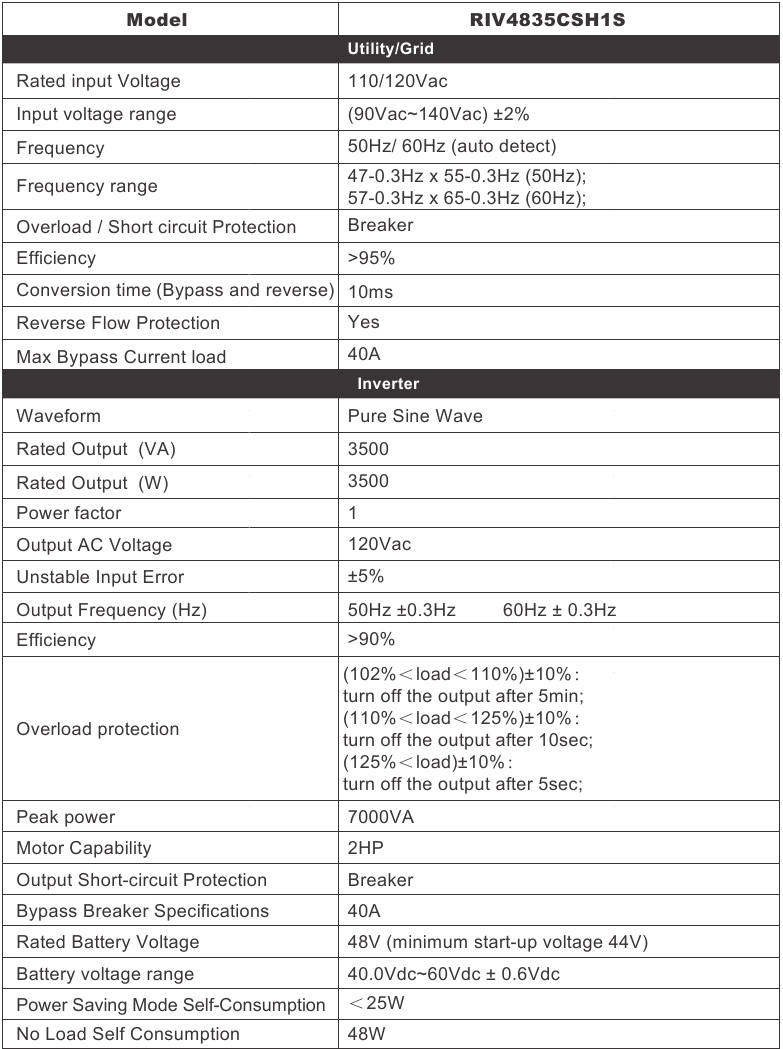
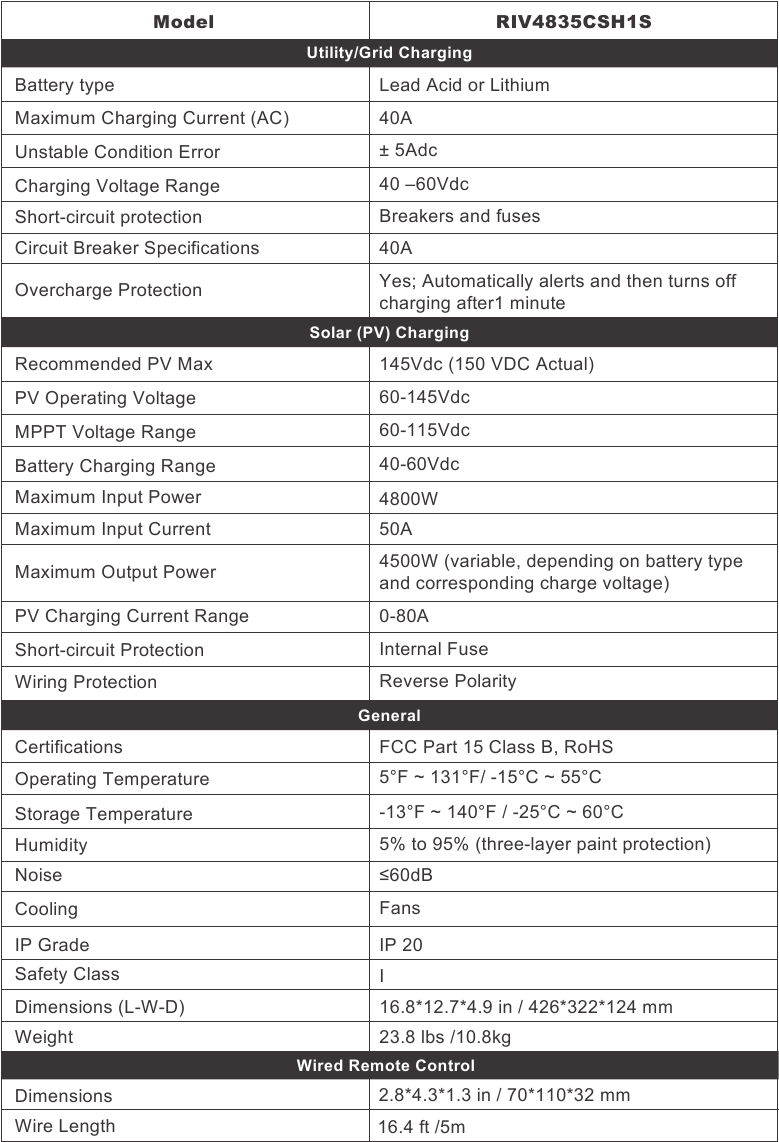
Non-Lithium Battery Parameters
| Battery type Parameters | SLD/AGM | GEL | Flooded Lead Acid (FLD) | USER (Default) | Custom Range |
| Over Voltage Disconnect | 60V | 60V | 60V | 60V | N/A |
| Over Voltage Disconnect Recover | 58.2V | 58.2V | 58.2V | 58.2V | N/A |
| Equalization Voltage [16] | - | - | 59.2V | 59.2V(adjustable) | 48~59.2V |
| Boost Voltage [09] | 58.4V | 56.8V | 58.4V | 58.4V(adjustable) | 48~58.4V |
| Float Voltage [11] | 55.2V | 55.2V | 55.2V | 55.2V(adjustable) | 48~58.4V |
| Under Voltage recover | 44.8V | 44.8V | 44.8V | 44.8V | N/A |
| Low Voltage Warning [14] | 43.8V | 43.8V | 43.8V | 43.8V(adjustable) | 40~52V |
| Low Voltage Disconnect Recover [35] | 50.4V | 50.4V | 50.4V | 50.4V(adjustable) | N/A |
| Low Voltage Disconnect [12] | 42V | 42V | 42V | 42V (adjustable) | 38~50V |
| Discharge Limit Voltage [15] | 40V | 40V | 40V | 40V (adjustable) | 36~50V |
| Over-discharge Delay Time [13] | 5S | 5S | 5S | 5S (adjustable) | 5~50S |
| Equalization Duration [18] | - | - | 120 minutes | 120 minutes (adjustable) | 5~900 minutes |
| Equalization Interval [20] | - | - | 30 days | 30 days(adjustable) | 0~30 days |
| Boost Duration [10] | 120 minutes | 120 minutes | 120 minutes | 120 minutes(adjustable) | 5~900 minutes |
When modifying parameters in User Mode, the following rules must be followed to set parameters successfully.
- Overvoltage Disconnect > Overvoltage Disconnect Recover ≥ Equalization voltage ≥ Boost voltage ≥ Float voltage
- Overvoltage Disconnect > Over Voltage Disconnect Recover
- Low Voltage Disconnect Recover > Low Voltage Disconnect (at least 2V Smaller) < Discharge Limit Voltage
- Undervoltage Recover > Undervoltage Alarm

Lithium Battery Parameters
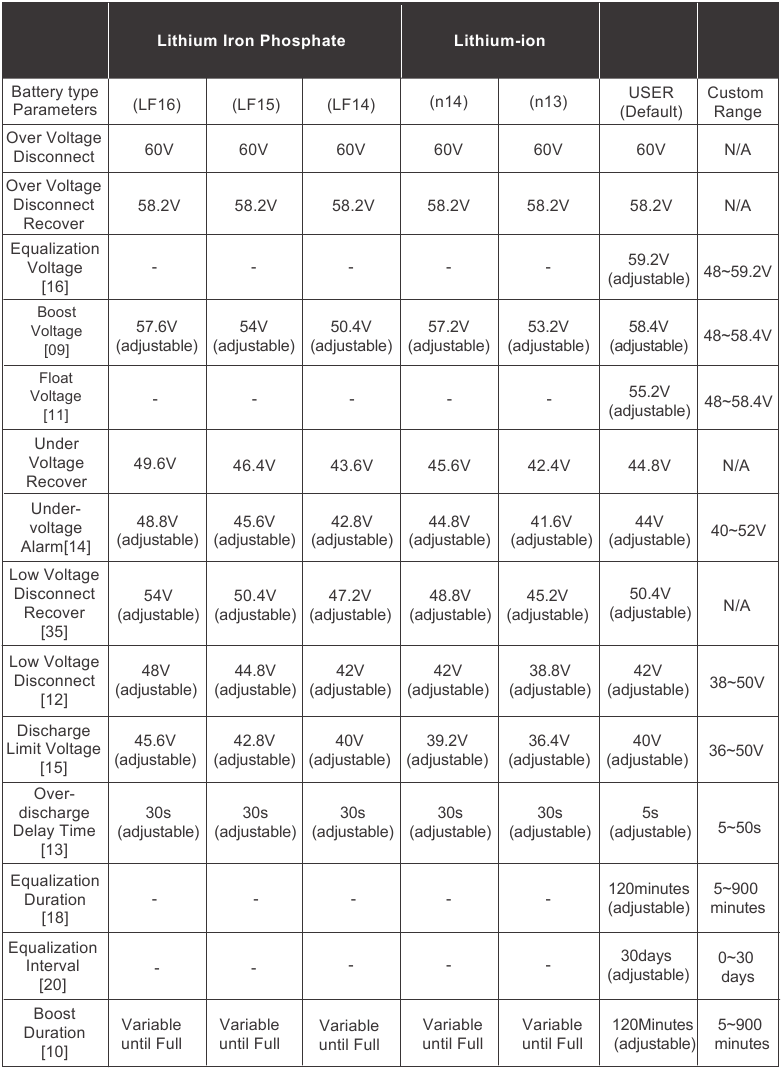
When modifying parameters in User Mode or Lithium, the following rules must be followed to set parameters successfully.
- Overvoltage Disconnect > Overvoltage Disconnect Recover ≥ Equalization voltage ≥ Boost voltage ≥ Float voltage
- Overvoltage Disconnect > Over Voltage Disconnect Recover
- Low Voltage Disconnect Recover > Low Voltage Disconnect (at least 2V Smaller) < Discharge Limit Voltage
- Undervoltage Recover > Undervoltage Alarm

If setting the Low Voltage Disconnect in User Mode, it must always be at least 2V lower than the Low Voltage Disconnect Recovery Voltage
Charging Parameters Glossary
- Overvoltage Disconnect—When and if the charge controller experiences a voltage higher than what is assigned, it will disconnect itself from the circuit; ceasing charge.
- Overvoltage Recover-- in the event a charge controller experiences an over-voltage condition set by the previous parameter, then this reconnecting parameter is put into play to direct the controller when it can connect and safely charge again. Typically over-voltage re-connection is achieved when time has passed (ex. The sun setting), or when the over-voltage condition is remedied ultimately reducing the voltage to a user defined charging voltage.
- Equalization Voltage-- equalization voltage is a corrective over-charge of the battery. The user should consult their battery manufacturer regarding specific battery equalization capacity. This parameter sets the equalization voltage to set the battery at when it reaches the equalization state.
- Boost Voltage-- users should check with their battery manufacturer for proper charging parameters. In this stage, users set the boost voltage where the battery will reach a voltage level and remain there until the battery undergoes an absorption stage.
- Float Voltage-- once the charge controller recognizes the set float voltage, it will commence floating. The battery is supposed to be fully charged in his state, and the charge current is reduced to maintain battery stability levels.
- Undervoltage Recover-- deals with the loads connected to the system. When batteries are determined to be low due to them approaching low voltage disconnect, then the loads will be shut off to give the batteries time to recover. This parameter sets the controller to shut off the loads until it can reach the low voltage reconnect stage.
- Undervoltage Alarm-- this parameter deals with the batteries themselves approaching the under-voltage recovery state. The user should minimize loads before the charge controller approaches a level where it will do this automatically to protect the battery from discharging.
- Low Voltage Recover-- parameter allows loads connected to the system will be able to operate (not fully) again.
- Low-voltage disconnect-- prevents over-discharge of the batteries by automatically disconnecting any loads. This extends battery life and is the precedent to being in an under-voltage state, recovering from the undervoltage state, and finally reconnecting to normal operational state.
- Discharging limit Voltage-- This parameter ensures that the controller does not exceed the default or assigned parameter before needing to be charged again. This is put into play to optimize and extend the battery life by going with a higher voltage. The lower the discharge limit voltage the more negative effect on battery efficiency.
CONTACT INFORMATION
US
5050 S Archibald Ave, Ontario, CA 91762
909-287-7111
www.renogy.com
support@renogy.com
CA
https://ca.renogy.com
supportca@renogy.com
UK
https://uk.renogy.com
supportuk@renogy.com
Important Safety Instructions
Please save these instructions.
This manual contains all safety, installation and operating instructions for the Solar Inverter Charger. The following symbols are used throughout the manual:
 | Indicates a potentially dangerous condition. Use extreme caution when performing this task. |
 | Indicates a critical procedure for safe and proper operation of the inverter. |
 NOTE NOTE | Indicates a procedure or function that is important to the safe and proper operation of the inverter. |
General Safety Information
- Installation and wiring must comply with the Local and National Electric Codes (NEC) and must be done by a certified technician.
- Read all of the instructions and cautions in the manual before beginning the installation.
- There are no serviceable parts for this inverter. Do NOT disassemble or attempt to repair the inverter.
- Make sure all connections going into and from the inverter are tight. There may be sparks when making connections, therefore, make sure there are not flammable materials or gases near installation.
- DO NOT attempt to touch the unit while it is operating as temperatures will be very hot. In addition, do not open the terminal cover while the unit is in operation.
- Installing breakers or fuses outside of the unit is recommended.
- After installation, check that all line connections are tight and secured.
- DO NOT parallel this device with other AC input sources to avoid damage.
Battery Safety
- Do NOT let the positive (+) and negative (-) terminals of the battery touch each other.
- Use Lithium batteries or deep cycle Sealed Lead Acid, Flooded, Gel, AGM batteries.
- Explosive battery gases may be present while charging. Be certain there is enough ventilation to release the gases.
- Be careful when working with large lead acid batteries. Wear eye protection and have fresh water available in case there is contact with the battery acid.
- Over-charging and excessive gas precipitation may damage the battery plates and activate material shedding on them. Too high of an equalizing charge or too long of one may cause damage. Please carefully review the specific requirements of the battery used in the system.
Installation Safety
- The unit should be installed in a well-ventilated, cool, and dry environment. Make sure the fans of the unit and the ventilation holes are not blocked.
- Do not expose the unit to rain, moisture, snow, or liquids of any type.
Documents / Resources
References
![www.renogy.com]() Renogy US Official | Trusted Energy Solutions
Renogy US Official | Trusted Energy Solutions![ca.renogy.com]() Renogy CA Official | Trusted Energy Solutions
Renogy CA Official | Trusted Energy Solutions![uk.renogy.com]() Renogy UK Official | Trusted Energy Solutions
Renogy UK Official | Trusted Energy Solutions
Download manual
Here you can download full pdf version of manual, it may contain additional safety instructions, warranty information, FCC rules, etc.
Advertisement
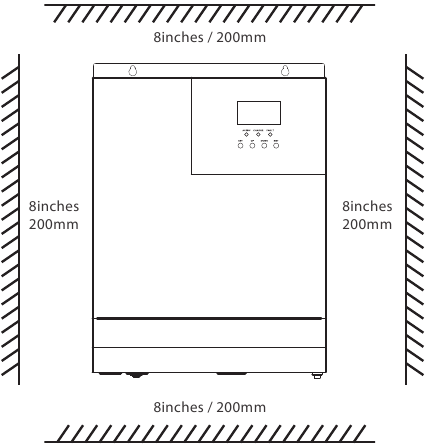






















Need help?
Do you have a question about the 48V and is the answer not in the manual?
Questions and answers